Great New 2-Volume Reference, “The Encyclopedia of Music in Ireland”
I spent an enjoyable Saturday morning reading about some of the early pioneers of traditional Irish and Celtic music—like the 17th century harpist and classical composer Turlough Carolan, the veritable Scarlatti of Ireland, and the 1920s fiddler Michael Coleman, a seminal figure who brought his technique and style from County Sligo to New York City in 1914, and inspired dozens of players in succeeding decades. I also sought out entries on several of my favorite contemporary Irish musicians: Mick Moloney, singer, multi-instrumentalist, educator, folklorist, musicologist, bandleader, and early facilitator of Cherish the Ladies; Liz Carroll, Chicago fiddler; Kevin Burke, Sligo fiddler; and Martin Hayes, Seattle fiddler, with whom my late Franconia College friend Rob Adams took some lessons in the 1990s; and bands like Boys of the Lough.
I was glad that I got to attend the launch event for The Encyclopedia of Music in Ireland (aka as EMIR within the two-volume set) at the Irish American Historical Society across from the Metropolitan Museum of Art on Fifth Ave one cold night last month. At rush hour it took me quite a while to get across Central Park from my office on the upper west side of Manhattan. When I finally got to the east side, the sun was setting vividly over the park, with a last peek of it along the horizon line.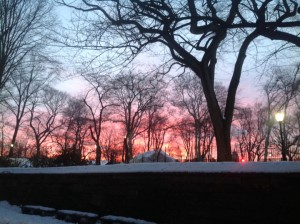
Late though I was, I managed to enter the room just as Irish novelist Colm Tóibín was offered the floor to speak about the encyclopedia. I shed my coat, and spotted friend Jack Lamplough, who in helping the publisher promote the book, had invited me for the occasion. There were close to seventy-five people already there. Holding both volumes as in his hands as he spoke, Toibin offered sincere remarks about the amazing breadth of the encyclopedia, encompassing as it does orchestral music and musicians, operatic performers, folk music and its practitioners, popular artists, rock n’ rollers, and more.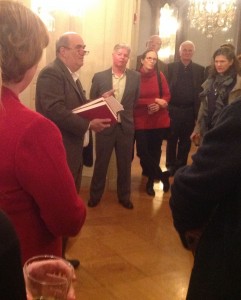
While encyclopedias and multi-volume reference books were common in prior decades of publishing, and I worked on a few, examples of publishing like this are uncommon in the present era of digital publishing. This two-volume set, from University College Dublin Press, is a superb piece of publishing, with over 2,000 entries, and more than 200 contributors assembled by general editors Harry White and Barra Boydell, both of whom were on hand, and spoke after Toibin. Not only does it have biographical articles on individual artists and bands, such as Liam Clancy, James Galway, Bob Geldof, Them (Van Morrison’s early outfit who, according to the entry, were in 1965 “the first Irish band of the Beatles era to have a British hit with ‘Baby, Please Don’t Go'”), The Pogues, and Thin Lizzy, it orders the entire world of Irish music with such granular categories and topics as: “Bells and bell-ringing,” “Bodhrain” (‘defined in a 1904 dictionary of Irish as a deaf person, a person of indifferent hearing, an indistinct person, a shallow skin-bottomed vessel…a drum’), “Canada: Irish traditional music,” “Dublin,” “The Gaelic League,” and “Police bands.”
During my years at Franconia College, the aforementioned Rob Adams, and the third member of our tight troika of friendship, Karl Petrovich, opened my ears to traditional music from Ireland, Scotland, all of the British Isles, and Appalachia. During those years, a Franconia professor and friend, William Congdon, introduced me to the music of English composer Ralph Vaughan Williams (1872-1958), who like a British Alan Lomax, collected folk songs from ordinary people in the field, and combined folk melodies with modernist elements in his magnificent output of orchestral and chamber music. After my college years, when I ran Undercover Books with my siblings and parents, I sold folk and traditional albums in our stores and at live events, like when Mike Seeger and the great Elizabeth Cotton played at a Cleveland venue (if you don’t happen to know her music, here she is playing “Freight Train“). When I moved to New York City in 1985, I lived in the Washington Heights section of Manhattan, close to Inwood, an Irish enclave where live music was played in bars I walked to or rode my bike to on weekend afternoons. North of Inwood in the Bronx was Gaelic Park, an outdoor sports venue where I watched teams from Ireland compete in hurling and Irish football matches. I was quite sure I was one of the only New Yorkers there without Irish roots. I also listened to Irish music on local radio station WFUV, which every week carried the Thistle & Shamrock program hosted by Fiona Ritchie, notable emissary of Celtic music, herself author of the recently published Wayfaring Strangers: The Musical Voyage from Scotland and Ulster to Appalachia, a music book I’m eager to add to my library. This music will always be close to my heart. I relish the opportunity to experience and enjoy it afresh with the new encyclopedia, and to read about all the other forms of music that have flourished among the Irish.
I’m grateful to Jack Lamplough for recognizing me and my blogs as press and offering me The Encyclopedia of Music in Ireland for review. I’ll continue writing about it, recommending it, and enjoying it for a long time. And now for your listening and viewing pleasure, below is a youtube recording of reels by Michael Coleman, more pictures from the reception, and of the encyclopedia itself, with ordering information.
- The entry on Michael Coleman charts his path from Ireland to NYC. Notice the breadth of EMIR as show in the entry above “George M. Cohan,” played memorably by James Cagney in the movie musical “Yankee Doodle Dandy.”
- The elegant volumes have bookmark ribbons sewn in.
- Slipcase portrait shows Kathleen Ni Houlihan, also seen on Irish currency. Her arm rests on the Irish harp.
- Nest of slipcased sets
- Slipcase copy
- Jigs & Reels
- Encyclopedia ordering info

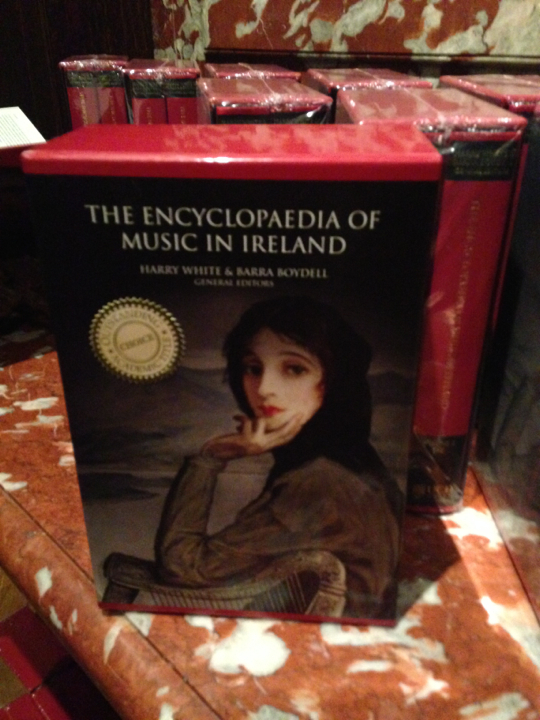


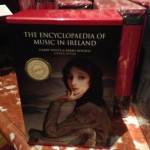




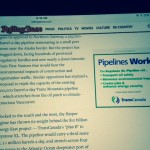
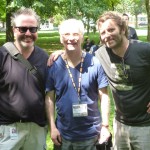
Leave a Reply
Want to join the discussion?Feel free to contribute!